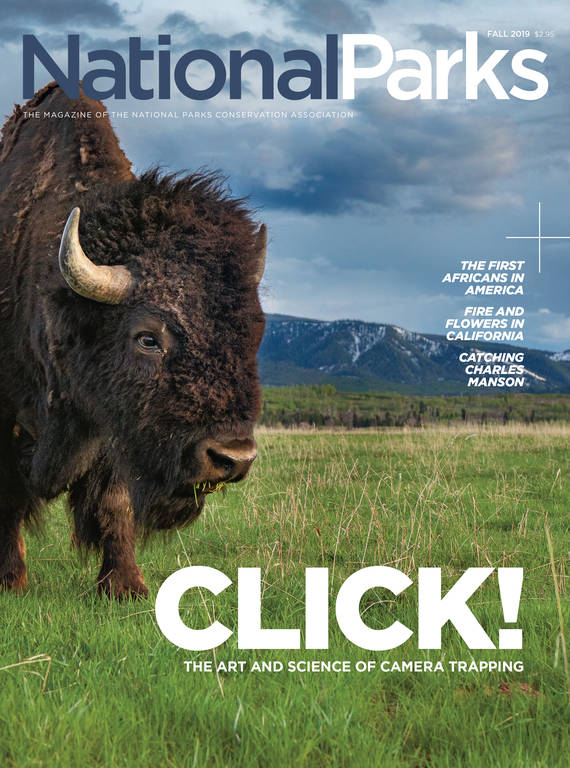Fall 2019
A Momentous Arrival
Four hundred years ago, a pirate ship carrying enslaved Africans pulled into Point Comfort in Virginia. Was it the beginning of slavery in this country?
These days, not much happens on the T-shaped wooden fishing pier that juts out of the seawall south of Fort Monroe in Hampton, Virginia. Seagulls ride the breeze overhead, and the occasional motorboat glides by as anglers cast their lines for striped bass, white perch and rockfish.
But the tranquility of this spot belies its dramatic history: 400 years ago, the arrival of a ship here, where the James River meets the Chesapeake Bay, profoundly altered the course of what would become the United States of America. In late August 1619, a battered English ship called the White Lion docked at what was then known as Point Comfort with some unexpected passengers.
A few weeks earlier, the White Lion and the Treasurer, another privateer (a state-sanctioned pirate ship), had teamed up to attack a Spanish vessel known as the San Juan Bautista. The English mariners hoped the Spanish ship carried gold in its hold, but instead they found hundreds of enslaved Africans aboard. The pirates seized about 60 of them and eventually found their way to the Colony of Virginia. The White Lion got there first, its crew famished after months at sea. They sold a couple dozen of their captives to two of Virginia’s wealthiest settlers so they could buy food.
Historians still debate whether slavery in this country started right then and there. Decades before slavery was institutionalized, were these Africans considered slaves or were they treated more like the colony’s labor force of white indentured servants who were able to gain their freedom after years of servitude? Scholars disagree over the answer to that question, but they concur that the unplanned capture of the Africans and their arrival at Point Comfort paved the way for the subjugation of one race to another, the consequences of which the nation wrestles with to this day.
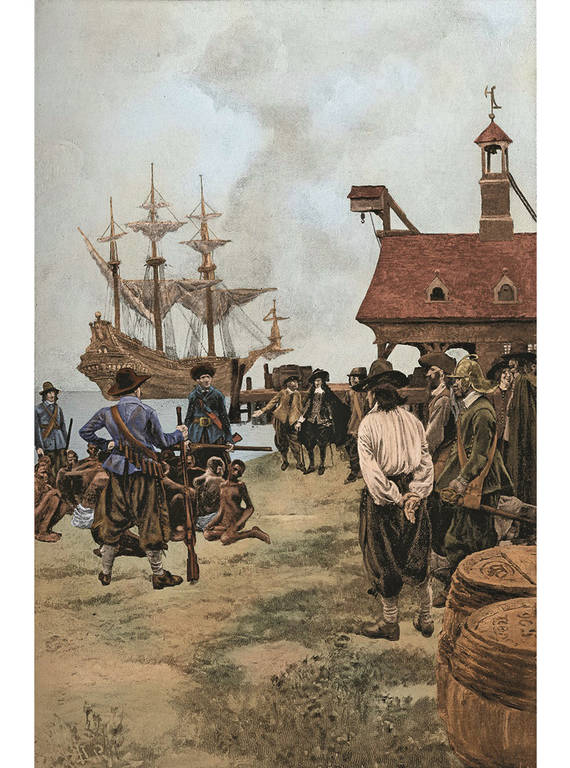
This illustration, made by Howard Pyle more than a century ago, depicts the arrival of the first Africans at Jamestown. Until recently, historians thought the Africans landed there, a misperception that remains widespread.
© LEBRECHT MUSIC & ARTS/ALAMY STOCK PHOTOHow to commemorate an event that led to two centuries of slavery is a delicate affair. Every August, a few hundred people congregate at the landing site for a day of prayers, speeches, and traditional African music and dance. Participants throw flower petals in the water to honor the memory of Virginia’s first Africans. It’s an emotional day, and people often cry as they contemplate the ordeal of those who were taken by force from their homeland and transported in brutal conditions to a strange land, said Calvin Pearson, a Hampton native and one of the annual event’s main organizers. Pearson sees the first Africans as the ancestors of today’s African American population, and he hopes that the 400th anniversary of their landing in Virginia will help turn Fort Monroe into a place of pilgrimage for African Americans interested in connecting with their roots.
“This is the true beginning of Africans in English North America,” he said recently from the landing point, gazing in the direction the White Lion might have come from four centuries ago. “We call Point Comfort a sacred land.”
This is a big moment for Hampton, a city with a large African American population. Unlike Jamestown, the colony’s first permanent settlement, Hampton attracts only a small number of colonial history enthusiasts, but locals hope the anniversary will begin to change that. Their task has been complicated by the widespread perception that Jamestown, where several of the first Africans eventually lived, was the site of the Africans’ arrival. (As recently as February, film director Spike Lee made that erroneous claim during his Academy Awards acceptance speech.)
Pearson and others have worked hard to correct the record. They successfully pushed Jamestown staff to amend their exhibits, oversaw the installation of an updated historical marker at Fort Monroe in 2015 and are raising funds for the construction of a memorial. “We must remind people that this is the landing point and not Jamestown,” said William Wiggins, a local historian.
Fort Monroe National Monument, a national park site established just eight years ago by President Barack Obama, also has a lot riding on the anniversary. A 2014 study showed that most of the visitors to the site — a 328-acre park comprising a fort, historic buildings and beaches — are Virginians. Terry Brown, a 28-year National Park Service veteran who became Fort Monroe’s superintendent in 2016, has some ideas about how to draw tourists from farther afield and promote the fledgling park. He is overseeing the construction of a new visitor center, planning new tours and partnering with local organizations to fill the park calendar with events. “I want to create my own traditions,” he said.
The current fort, which was built in part by enslaved laborers, was completed in 1834 on the location of Fort Algernourne, a simple earthwork dating back to 1609. The fortification was never the site of a major battle, but a remarkable cast of historical figures passed through, from writer Edgar Allan Poe, who was stationed here as a soldier, to Confederate Gen. Robert E. Lee, who oversaw the end of the fort’s construction as a young West Point-trained engineer, to Confederate President Jefferson Davis, who was held in one of the fort’s prison cells at the end of the Civil War.
The site’s rich African American history extends well beyond the arrival of the first Africans. According to an account by Maj. Gen. Benjamin Butler of the Union Army, in 1861, just a month after the beginning of the Civil War, three enslaved men escaped to Fort Monroe from a nearby artillery position where they had been put to work by their owner, a Confederate officer. In a momentous decision, Butler declared the men “contraband of war” and refused to return them. Thousands of enslaved people followed, heading for the fort — nicknamed “Freedom’s Fortress” — and other Union strongholds. By the end of the war, tens of thousands of freedom seekers had found safety behind Union lines. The contraband decision paved the way for President Abraham Lincoln’s Emancipation Proclamation in 1863 and the 1865 passage of the 13th Amendment, which abolished slavery.
“The African American history here overshadows in many respects the military history,” said Pearson, who calls Fort Monroe “one of America’s greatest African American national parks.”
Brown, the superintendent, has made a point of reaching out to Hampton’s African American residents, participating in community events and helping fund school trips to the park. This year, he launched a black history tour that stops at sites in and around the monument. Brown, who is African American, wants visitors to make a personal connection to the park, as he has. “My family goes all the way back to Cameroon,” he said in his office, located in Lee’s former quarters. “Sometimes I’m thinking: ‘Did some of my ancestors come through here?’”
Historians say the 1619 landing was a pivotal moment with a complex legacy. The discrimination, racial prejudice and race-based inequalities that remain pervasive today can be traced back to the first Africans’ arrival, said Cassandra Newby-Alexander, a history professor at Norfolk State University. Just a few years after the pirates sold them, the Africans were listed as “others” in the colony’s census and treated accordingly by Virginia’s colonists. “America became a black and white society at that point. It got incorporated in the law, and it got incorporated in the psyche of Americans,” she said.
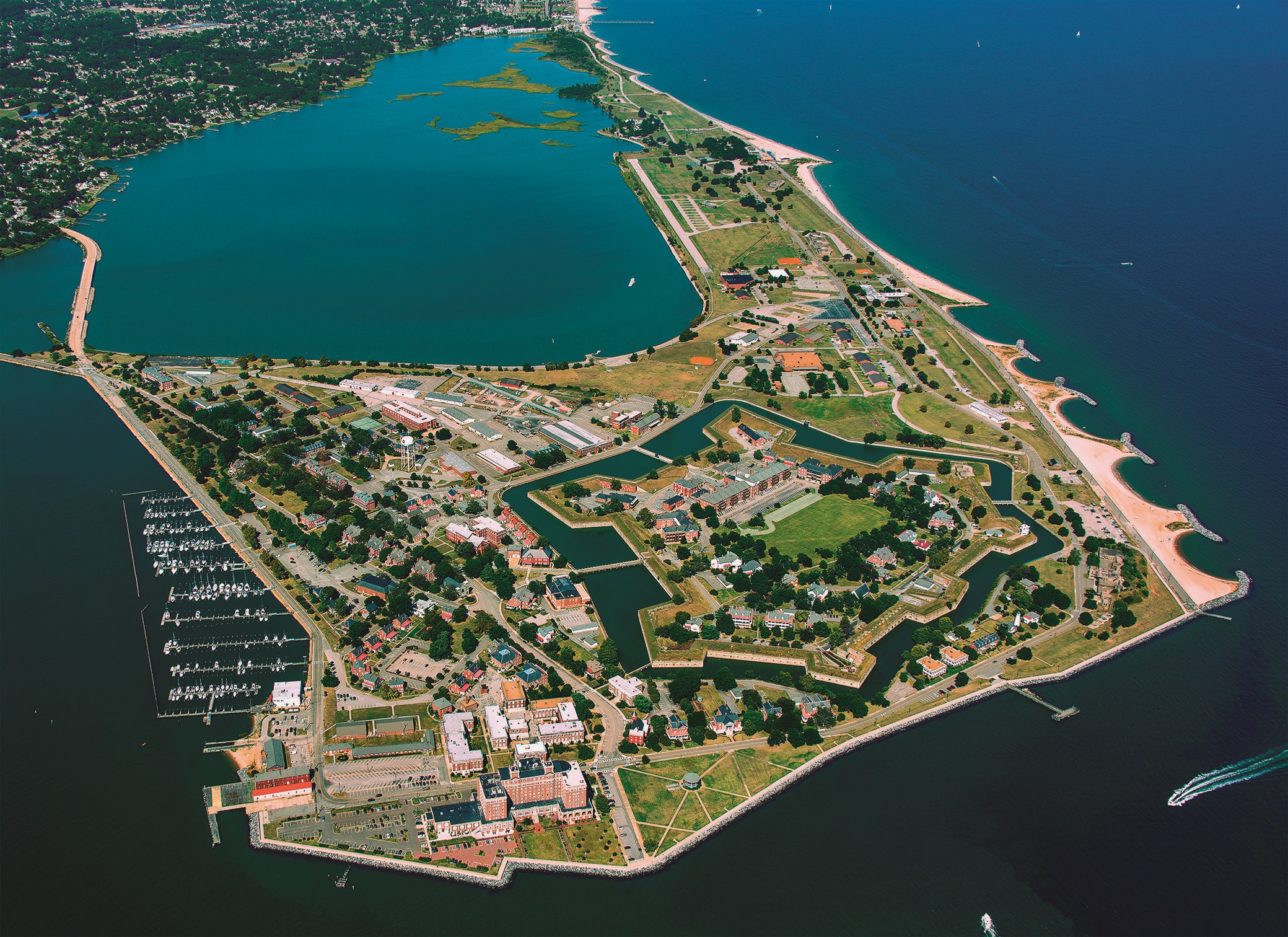
Fort Monroe National Monument was established in 2011 by former President Barack Obama. The T-shaped pier marking the first Africans’ landing site juts out from the seawall south of the fort. NPS
In addition, the Africans came with skills that helped Virginia’s plantations thrive at a time when the colony was floundering. This eventually led to the arrival of more African slaves in Virginia and other North American colonies who contributed greatly to the economy of the region before and after U.S. independence.
The San Juan Bautista, which left the coast of present-day Angola in early 1619, was one of dozens of slave ships that carried captives to Spanish and Portuguese colonies that year. The Portuguese and their local allies had waged a campaign in the Kingdom of Ndongo, in Angola’s interior, that led to the capture of thousands of people. The war destroyed the kingdom’s capital and decimated the population, said John Thornton, a professor of African American studies at Boston University.
Most of the details about the Africans’ arrival in Virginia come from a single paragraph in a January 1620 news update that John Rolfe, an early English settler and by then the widower of Pocahontas, wrote to the Virginia Company’s treasurer. In his letter, Rolfe mentioned that at the end of August 1619, the White Lion brought “20 and odd negroes,” whom the colony’s governor and its trade agent bought “at the best and easiest rates they could.” The second ship, the Treasurer, arrived three or four days later, and according to the recent work of historian Martha McCartney, the pirates may have traded two or three additional Africans with Virginia’s colonists.
There is no known description of the captives, but accounts of similar journeys detail the harrowing conditions endured by enslaved people on their transatlantic journey, so it’s likely they arrived emaciated and in poor health. Cramped spaces, lack of fresh air, disease, and inadequate food and water took a devastating toll. More than a third of the San Juan Bautista’s original 350 enslaved Africans died on board. (The roughly 115 enslaved Africans who remained on the ship after the encounter with the White Lion and the Treasurer were sold in Mexico; before the attack, 24 had been sold in Jamaica.)
Little information exists about the Africans’ early years in Virginia. The 1620 census shows that 32 Africans — 17 women and 15 men — were living in the colony. They were described only as “others not Christians in the service of the English.” Four years later, their population had dwindled to 21 or 22, likely as a result of disease and attacks by Virginia Indians. In 1624, a dozen Africans are listed by name in the historical record. Those individuals include Anthony and Isabella, who are described as members of an estate in Elizabeth City. The property, now part of Hampton, belonged to Capt. William Tucker, a prominent settler. Anthony and Isabella are significant because by 1625, they are recorded as the parents of William. He and another unnamed child listed on that year’s census are the first known children born of African parents in colonial America.
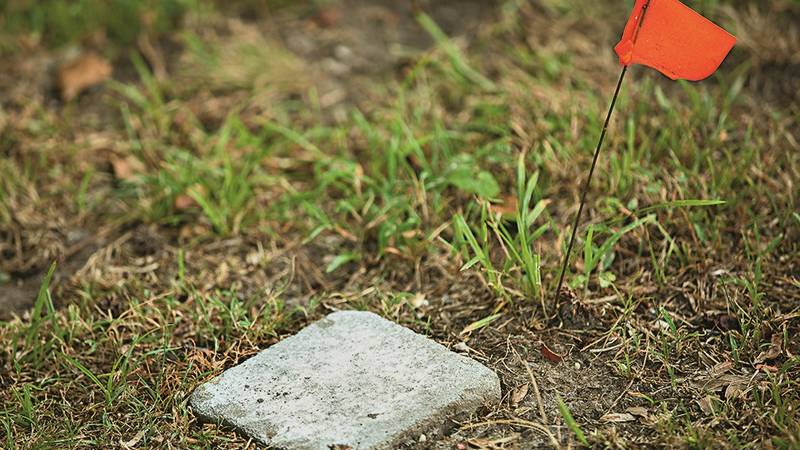
Several unmarked graves were discovered in the Tucker family’s cemetery when family members and local residents cleared the plot from overgrowth a few years ago. They are now marked with small stones and flags.
© HEATHER HUGHES OSTERMAIERArchaeology has provided few additional details. An ongoing excavation of the Jamestown household of Capt. William Pierce, where an African woman named Angelo or Angela lived after arriving on the Treasurer, has yielded little aside from tools, pottery fragments and cowrie shells that may be connected to Angela. Historians say Bluebird Gap Farm in Hampton, which some believe to be the site of Capt. Tucker’s estate, would be a good spot for an excavation, but digging there is a distant prospect because of limited resources.
Today, Bluebird Gap is a family attraction with farm animals, a playground and peacocks wandering the grounds. One late afternoon, I visited the farm with Wiggins, a former history professor at Hampton University, and we spoke to Adam Newland, the farm’s manager. He told us that he had recently uncovered ancient bricks while installing a fence for a new turtle enclosure, but without formal research, the area’s significance remains speculative. “The legend says there was a slave graveyard over there,” Newland said, motioning toward the woods behind the turtle pen.
Historians who believe that the first Africans were slaves say that the Virginia colonists were very familiar with prevalent racism toward Africans in English society and knew slavery was growing in Brazil, Mexico and other colonies. They point to the fact that unlike white indentured servants, Africans had no written contract that guaranteed an end to their servitude and that the occasional African who later gained his freedom was the exception rather than the rule. They also note that the Africans were enslaved on the San Juan Bautista and were sold as commodities. “It does a disservice to the people that came here as slaves and the challenges they faced to call them anything other than what they were, which is slaves,” said James Horn, president of the Jamestown Rediscovery Foundation and the author of “1619: Jamestown and the Forging of American Democracy.”
Other historians contend that saying the Africans were slaves from the beginning negates the deliberate establishment of slavery by white colonists in the decades that followed the 1619 landing. Wiggins notes that the initial, limited opportunities Africans had to secure their freedom quickly vanished as the colony codified slavery through a series of laws and court rulings over the course of the 17th century. One of those decisions was a verdict on the escape of three servants from Virginia into Maryland in 1640. The two white escapees were sentenced to lashes and saw their indenture contracts extended by several years, but John Punch, who was black, received a harsher sentence. “He was told after being soundly whipped: ‘You will serve for the rest of your life,’” said Wiggins, who views the ruling as a milepost in the transition toward institutionalized slavery.
Identifying descendants also can be contentious. It’s likely that the first Africans had more children than the two documented in the census and that their descendants are still around today. But because the evidence is spotty, historians say tracing one’s ancestry to the original Africans is an impossible quest. “There is a real frustration with how little is really known, and so there is that temptation to fill in the story more,” said Beth Austin, a historian at the Hampton History Museum.
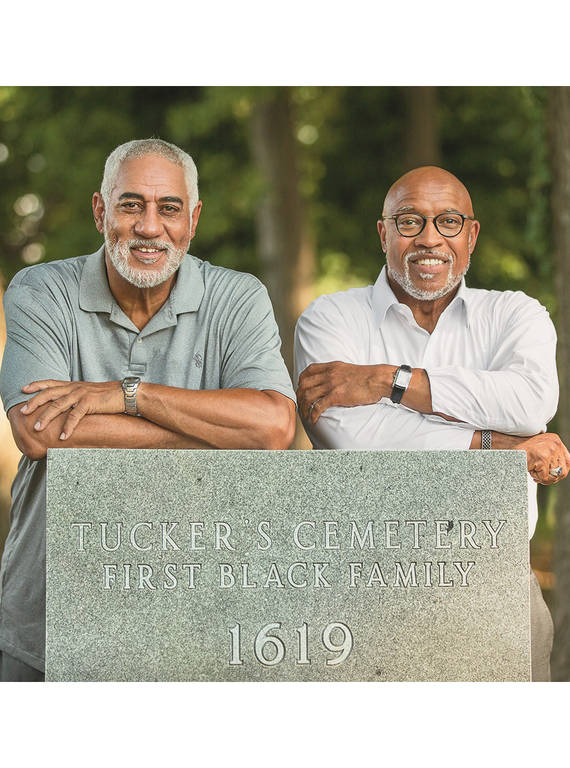
Walter Jones (left) and Verrandall Tucker (right) at the family’s cemetery in Hampton, Virginia. Jones and Tucker believe they are descendants of William, one of the first children born of African parents in colonial America.
© HEATHER HUGHES OSTERMAIERSome genealogy sleuths have attempted to close the gap. A few years ago, Kathryn Knight, a Florida-based land developer turned professional genealogist, discovered that her husband was a descendant of Margaret Cornish, who Knight believes arrived on the White Lion. Knight became obsessed with the story of Cornish and other original Africans. She pored over archives and books and started a databank to store the DNA profiles of people who thought they might be related to the first Africans. “I believe we’ll be able to find all the descendants, and I believe there are a lot,” she said. Knight published a book, “Unveiled: The Twenty & Odd,” about her findings, but historians who have looked at her research are not convinced, saying it’s nearly impossible to make such connections without a more detailed historical record and DNA material from the first Africans.
The strongest claim to a direct line to the first Africans is that of the Tucker family, who consider themselves descendants of William, the son of Anthony and Isabella. Tucker was, of course, the name of the owner of the colonial estate, and Tucker family members believe that William took the moniker.
I met a Tucker, Carolita Jones Cope, at the family’s cemetery, which is located less than a mile from Bluebird Gap Farm — the supposed location of Capt. Tucker’s property. Cope’s late grandfather said the family’s ancestors lived there, and Cope’s cousin, who spent much of her adult life researching the lineage of the Tucker family, not only believed that Anthony and Isabella’s son was their relative but also thought he was buried in the family’s cemetery.
Cope, her relatives and local residents cleared the overgrown cemetery a few years ago. They located many unnamed graves and even unearthed a skull during the cleanup. The discoveries are tantalizing, but Cope isn’t keen on conducting further investigations to figure out whether William is indeed buried in the family plot.
“I’m so grateful that I’m a descendant of survivors, of people who had to fight to go through such a difficult experience,” she said while swatting mosquitos. “Let’s just try to let our ancestors rest in peace.”

National Parks
You can read this and other stories about history, nature, culture, art, conservation, travel, science and more in National Parks magazine. Your tax-deductible membership donation of $25 or more entitles…
See more ›NPCA AT WORK
The future of Fort Monroe was a big question mark in 2005. The site was on a list of U.S. military bases slated to be closed within six years, and commercial developers were salivating at the prospect of turning much of the peninsula into condominiums.
That’s when NPCA, along with local activists and leaders, stepped in to push for the creation of a national park site protecting the historically important fort. Making nearby beaches part of the park also was critical, they argued, partly because only a fraction of the Chesapeake Bay’s coastline (less than 1% today) is open to the public.
The campaign succeeded: In 2011, President Barack Obama established Fort Monroe National Monument, which includes a section of the beachfront. But NPCA has “unfinished business” at the park, said Pam Goddard, NPCA’s senior Mid-Atlantic program director. The problem is that the beach is separated from the fort by an area called the Wherry Quarter. That concerns conservationists, who worry about inappropriate development there and would like to see the monument’s two distinct parcels joined.
ABOUT THE PHOTOGRAPHER
Virginia has agreed to donate 40 acres for that purpose to the Park Service, and the state’s senators introduced a bill in July to enact the land transfer. To date, the agency has declined the gift, saying that it doesn’t want to take on additional maintenance costs. Mark Perreault, the president of Citizens for a Fort Monroe National Park, said that fear is unwarranted. Only a few buildings are located on the tract of land in question, and since they have no historical value, they could be razed to enhance the area’s natural setting. “The federal government would get it for nothing, which is a pretty good deal,” he said.
About the author
-
 Nicolas Brulliard Senior Editor
Nicolas Brulliard Senior EditorNicolas is a journalist and former geologist who joined NPCA in November 2015. He serves as senior editor of National Parks magazine.
